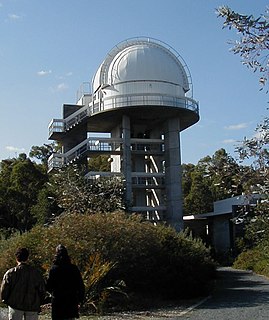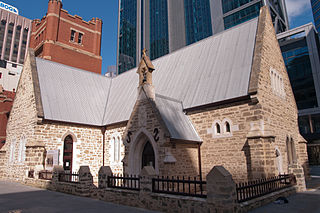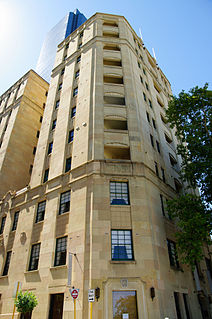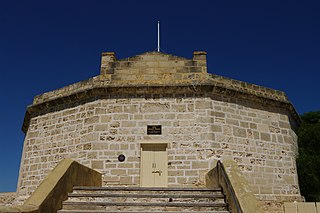Related Research Articles

The City of Bayswater is a local government area in the Western Australian capital city of Perth, about 7 kilometres (4 mi) northeast of Perth's central business district. The City covers an area of 34.6 square kilometres (13.4 sq mi) and has a population of 69,283 as at the 2021 Census. The City of Bayswater is a member of the Eastern Metropolitan Regional Council.

The City of Canning is a local government area in the southeastern suburbs of the Western Australian capital city of Perth, about 10 kilometres (6 mi) southeast of Perth's central business district. The City covers an area of 64.8 square kilometres (25.0 sq mi) and had a population of approximately 90,000 as at the 2016 Census.

The Perth Observatory is the name of two astronomical observatories located in Western Australia (WA). In 1896, the original observatory was founded in West Perth on Mount Eliza overlooking the city of Perth. Due to the city's expansion, the observatory moved to Bickley in 1965. The new Perth Observatory is sometimes referred to as Bickley Observatory.

The Western Australian Legislative Council is the upper house of the Parliament of Western Australia, a state of Australia. It is regarded as a house of review for legislation passed by the Legislative Assembly, the lower house. The two Houses of Parliament sit in Parliament House in the state capital, Perth.

The City of Perth is a local government area and body, within the Perth metropolitan area, which is the capital of Western Australia. The local government is commonly known as Perth City Council. The City covers the Perth city centre and surrounding suburbs. The City covers an area of 20.01 square kilometres (8 sq mi) and had an estimated population of 21,092 as at 30 June 2015. On 1 July 2016 the City expanded, absorbing 1,247 residents from the City of Subiaco.

Council House is a 13-storey office building on St Georges Terrace in Perth, Western Australia. Located beside Stirling Gardens and Government House in the city's central business district, the 49.8-metre (163 ft) building was designed by Howlett and Bailey Architects and opened by The Queen in 1963, after Perth hosted the 1962 British Empire and Commonwealth Games. For most of its history, it has served as the headquarters for the City of Perth.

The Shire of Boddington is a local government area in the Peel region of Western Australia, about 120 kilometres (75 mi) south-east of the state capital, Perth. The Shire covers an area of 1,901 square kilometres (734 sq mi), and its seat of government is the town of Boddington.

The City of Subiaco is a local government area in Western Australia. It covers an area of approximately 7 km² in inner western metropolitan Perth and lies about 3 km west of the Perth CBD. The City includes the historically working-class suburb of Subiaco centred around Rokeby Road. Since the 1990s the area has been extensively redeveloped and gentrified.

The Shire of Peppermint Grove is a local government area in Perth, Western Australia, 12 kilometres (7.5 mi) southwest of the Perth central business district. At 1.1 km2 (0.42 sq mi), it is the smallest local government area in Australia; it contains only the eponymous suburb, Peppermint Grove. The council comprises seven elected councillors, with no ward divisions.

The Shire of Murchison covers a large area of the Murchison sub-region of the central part of Western Australia, 300 kilometres (186 mi) northeast of Geraldton. The shire and the older 'Murchison' region and goldfield are now part of the designated Mid West region. It is Australia's second least populated local government area and the only one without a town.

Perth Institute of Contemporary Arts (PICA) is a contemporary visual and performance arts venue located in a heritage-listed building in Perth, Western Australia.

East Perth Cemeteries was the first cemetery established for the Swan River Colony in 1829 in East Perth, Western Australia. It is estimated that as many as 10,000 people were buried there between 1829 and 1919 in seven independently administered denominations or sections which is why the place is known as 'East Perth Cemeteries'. Only around 800 gravesites have been identified. A large section of the original site has since been built over, leaving about 5 hectares remaining.

The Old Perth Boys School, located at 139 St Georges Terrace, Perth, Western Australia, is the earliest government school building in Western Australia. The single-storey limestone building was designed by William Ayshford Sanford in 1852 and is a significant example of a colonial building constructed in Perth from the mid-nineteenth century.

The 1910 Perth Technical School building is located at 137 St Georges Terrace, Perth, Western Australia, adjacent to the Old Perth Boys School building, which had served as part of the school's former temporary premises since opening of classes there on 16 May 1900.

Lawson Apartments are located at 2–4 Sherwood Court near the corner with The Esplanade, in Perth, Western Australia. They are situated across the road from the Esplanade Reserve and adjacent to the Weld Club.

Lesbian, gay, bisexual and transgender (LGBT) rights in Western Australia have seen significant progress since the beginning of the 21st century, with male sex acts legal since 1990 and the state parliament passing comprehensive law reforms in 2002. The state decriminalised male homosexual acts in 1990 and was the first to grant full adoption rights to LGBT couples in 2002.
The National Trust of Western Australia, officially the National Trust of Australia (W.A.), is a statutory authority that delivers heritage services, including conservation and interpretation, on behalf of the Western Australian government and community. It is responsible for managing heritage properties and collections, as well as natural heritage management and education.

The State Register of Heritage Places is the heritage register of historic sites in Western Australia deemed significant at the state level by the Heritage Council of Western Australia.
References
- ↑ Hopkins, A. J. M (1986), Heritage legislation for Western Australia , retrieved 2 April 2012
- ↑ Western Australia (1990), Heritage of Western Australia Act 1990, Government Printer, retrieved 2 April 2012
- ↑ Heritage Council of Western Australia (1991), Heritage of Western Australia Act 1990, and Acts Amendment (Heritage Council) Act 1990 : a guide to the provisions of the acts, The Council, retrieved 2 April 2012
- ↑ Heritage Council of Western Australia; State Heritage Office. "About the State Heritage Register". Government of Western Australia. Archived from the original on 19 May 2015. Retrieved 22 June 2015.Additional archives: 25 July 2015 .
- ↑ Heritage in WA at National Trust of Australia (W.A.)
- ↑ "Home". Heritage Perth.
- ↑ Heritage Council of Western Australia (1992), Place matters : the newsletter of the Heritage Council of Western Australia, The Council, ISSN 1326-7280
- ↑ Heritage Council of Western Australia (1997), Heritage matters, Heritage Council of Western Australia, ISSN 1328-357X also the regional Heritage updates
- ↑ https://www.dplh.wa.gov.au/information-and-services/historic-heritage/heritage-grants-and-incentives WA Heritage Awards